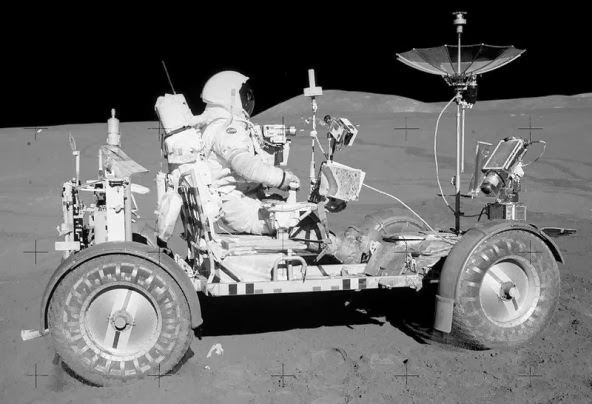The American Apollo program 15,16 and 17 that travelled to the moon during 1971 and 1972 carried Lunar Roving Vehicles(LRVs) or Moon buggies.
The astronauts (on Apollo 15 by astronauts David Scott and Jim Irwin,
one on Apollo 16 by John Young and Charles Duke, and one on Apollo 17 by
Eugene Cernan and Harrison Schmitt) drove the electric buggies around
the moon's surface, looking for interesting rocks. The Apollo Lunar
Roving Vehicle was an electric-powered vehicle designed to operate in
the low-gravity vacuum of the Moon and to be capable of traversing the
lunar surface, allowing the Apollo astronauts to extend the range of
their surface extravehicular activities.

The Lunar Roving Vehicle had a mass of 463 lb (210 kg), which resulted in a lunar weight of 77.2 lbf (35.0 kgf) - and was designed to hold a payload of an additional 1,080 lb (490 kg) on the lunar surface. The height of the vehicle was 3.6 feet (1.1 m). A T-shaped hand controller situated between the two seats controlled the four drive motors, two steering motors, and brakes. Moving the stick forward powered the LRV forward, left and right turned the vehicle left or right, and pulling backwards activated the brakes. Activating a switch on the handle before pulling back would put the LRV into reverse. Pulling the handle all the way back activated a parking brake. The control and display modules were situated in front of the handle and gave information on the speed, heading, pitch, and power and temperature levels.
All three buggies are still on the moon.

The Lunar Roving Vehicle had a mass of 463 lb (210 kg), which resulted in a lunar weight of 77.2 lbf (35.0 kgf) - and was designed to hold a payload of an additional 1,080 lb (490 kg) on the lunar surface. The height of the vehicle was 3.6 feet (1.1 m). A T-shaped hand controller situated between the two seats controlled the four drive motors, two steering motors, and brakes. Moving the stick forward powered the LRV forward, left and right turned the vehicle left or right, and pulling backwards activated the brakes. Activating a switch on the handle before pulling back would put the LRV into reverse. Pulling the handle all the way back activated a parking brake. The control and display modules were situated in front of the handle and gave information on the speed, heading, pitch, and power and temperature levels.
All three buggies are still on the moon.




